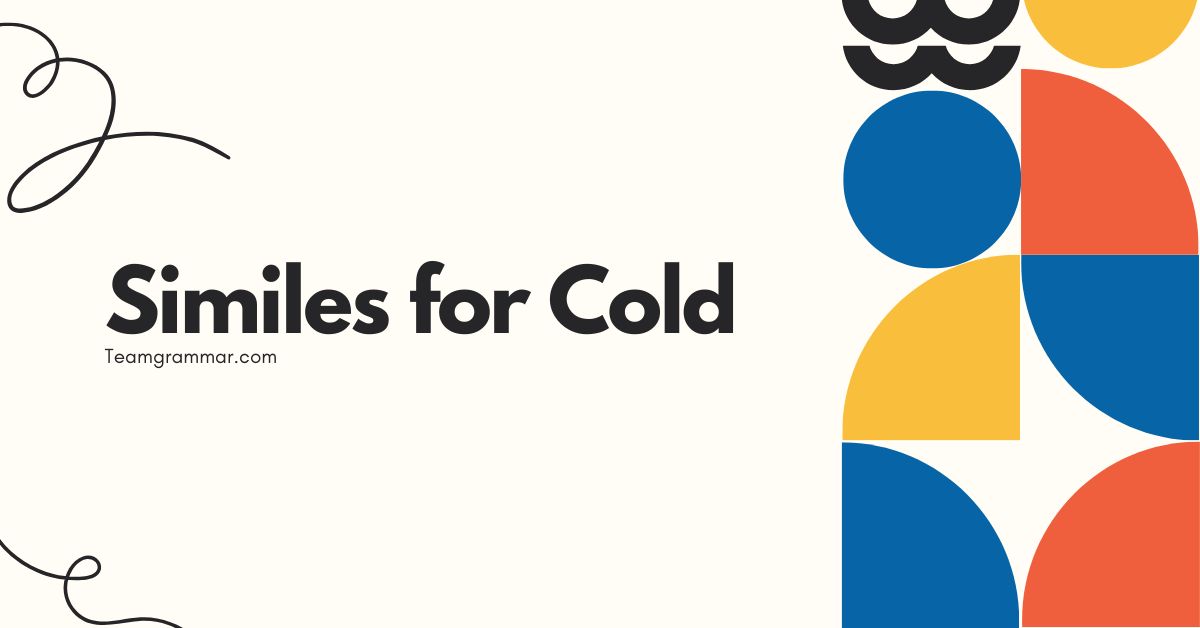35 Similes for Cold: Mastering Figurative Language
Understanding similes is crucial for enhancing your descriptive writing and adding vividness to your language. Similes, a type of figurative language, allow you to compare two unlike things using “like” or “as,” creating a clearer and more imaginative picture for the reader.
This article provides a comprehensive guide to using similes effectively to describe coldness, covering various categories, examples, and practical exercises. Students, writers, and English language learners will greatly benefit from this in-depth exploration.
Table of Contents
- Introduction
- Definition of Similes
- Structural Breakdown of Similes
- Types of Cold Similes
- Examples of Similes for Cold
- Usage Rules for Similes
- Common Mistakes When Using Similes
- Practice Exercises
- Advanced Topics in Similes
- Frequently Asked Questions
- Conclusion
Introduction
Similes are powerful tools in the English language, enabling writers and speakers to create vivid and memorable descriptions. By comparing something to a familiar object or concept, similes can evoke strong imagery and emotions.
This article focuses specifically on similes used to describe “cold,” exploring how they can be employed to convey not just temperature, but also emotional states, physical sensations, and general descriptive impressions. Mastering the art of using similes effectively will greatly enhance your ability to communicate clearly and creatively.
Whether you’re a student learning the basics of figurative language or a seasoned writer looking to refine your craft, this guide offers valuable insights and practical examples to help you excel.
Definition of Similes
A simile is a figure of speech that directly compares two different things using the words “like” or “as.” The purpose of a simile is to create a more vivid and descriptive image in the reader’s or listener’s mind by drawing a parallel between the two unlike subjects. Similes are essential for adding depth and color to writing, making it more engaging and memorable.
They help to convey complex ideas or feelings by relating them to something more familiar and easily understood. The effectiveness of a simile lies in the strength and relevance of the comparison, which should highlight a shared characteristic or quality between the two subjects.
Classification: Similes fall under the broader category of figurative language, specifically comparison figures. Other related figures of speech include metaphors (which imply a comparison without using “like” or “as”), analogies (which draw more extensive and complex comparisons), and personification (which attributes human qualities to inanimate objects or abstract concepts).
Function:The primary function of a simile is to enhance descriptive writing by creating a more vivid and relatable image for the audience. Similes can also be used to clarify complex ideas by comparing them to simpler, more familiar concepts.
Additionally, they can evoke specific emotions or moods by associating the subject with something that carries a particular emotional weight. Similes can transform mundane descriptions into something more engaging and memorable, adding depth and nuance to your writing.
Contexts:Similes are widely used in various forms of literature, including poetry, prose, and drama. They are also common in everyday speech, advertising, and other forms of communication where vivid and engaging language is desired.
In creative writing, similes are used to create imagery, convey emotions, and add depth to character descriptions. In persuasive writing, they can be used to make arguments more relatable and convincing.
Understanding how to use similes effectively is a valuable skill for anyone who wants to communicate with clarity and impact.
Structural Breakdown of Similes
The basic structure of a simile consists of three main components: thesubject, thecomparison word(either “like” or “as”), and theobject of comparison. The subject is the thing being described, while the object of comparison is the thing it is being compared to.
The comparison word serves as the bridge between the two, indicating that a similarity exists between them. The effectiveness of a simile depends on the relationship between these three components; a strong simile creates a clear and meaningful connection between the subject and the object of comparison.
Subject:This is the noun or pronoun that is being described or compared. It is the focal point of the simile and the element that the writer wants to illuminate.
For example, in the simile “The ice was as cold as a witch’s heart,” the subject is “the ice.”
Comparison Word: The comparison word is either “like” or “as.” These words signal that a comparison is being made and that the subject and object of comparison share a common characteristic. While both words serve the same basic function, “as” is often used when the comparison is based on a specific quality or attribute, while “like” can be used more broadly.
Object of Comparison:This is the noun or noun phrase that the subject is being compared to. It should be something that the audience is familiar with and that has a clear association with the quality being described.
In the example “The ice was as cold as a witch’s heart,” the object of comparison is “a witch’s heart.” This comparison evokes a sense of extreme coldness and malevolence, adding depth to the description.
Understanding the structural elements of a simile enables you to craft more effective and impactful comparisons. By carefully selecting the subject, comparison word, and object of comparison, you can create similes that resonate with your audience and enhance your writing.
Types of Cold Similes
Similes for “cold” can be categorized based on the aspect of coldness they emphasize. These categories include temperature, emotional state, physical sensation, and descriptive qualities.
Each category provides a unique way to convey the feeling of cold, allowing writers to create more nuanced and evocative descriptions.
Temperature Similes
These similes directly relate to the sensation of low temperature, often comparing the cold to familiar objects or environments known for their frigidity. They are used to convey the intensity and severity of the cold, helping the reader to imagine the physical sensation of being exposed to extreme cold.
Emotional Similes
Emotional similes use coldness to describe emotional states such as apathy, detachment, or cruelty. These similes draw a parallel between the physical sensation of cold and the feeling of emotional distance or lack of warmth.
They can be used to portray characters who are emotionally distant or to describe situations that evoke feelings of isolation and loneliness.
Physical Similes
These similes describe the physical effects of cold on the body, such as shivering, numbness, or stiffness. They focus on the tangible sensations associated with cold exposure, helping the reader to understand the physical impact of cold on the body.
These similes are particularly effective in creating a sense of realism and immediacy in writing.
Descriptive Similes
Descriptive similes use coldness to describe the appearance or atmosphere of a place or thing. These similes focus on the visual and atmospheric qualities associated with cold, such as the starkness of a winter landscape or the icy sheen of a frozen surface.
They can be used to create a sense of place and mood, adding depth and texture to the description.
Examples of Similes for Cold
The following sections provide examples of similes for cold, organized by the categories discussed above. These examples demonstrate the variety of ways in which similes can be used to describe coldness, showcasing their versatility and impact.
Temperature Examples
Temperature similes are designed to evoke the raw feeling of intense cold. They often compare the temperature to things universally known for being icy or freezing.
The following table provides examples of temperature similes.
| Simile | Explanation |
|---|---|
| As cold as ice | A classic simile emphasizing extreme coldness. |
| As cold as a freezer | Highlights the frigid temperature inside a freezer. |
| Like a walk-in refrigerator | Illustrates a large space with very low temperature. |
| As cold as a polar bear’s nose | Connects the cold to an animal adapted to freezing conditions. |
| Like the Arctic in winter | Refers to the extreme cold of the Arctic region. |
| As cold as a penguin’s feet | Relates the cold to another animal adapted to cold climates. |
| Like standing in a snowstorm | Evokes the feeling of being surrounded by frigid snow. |
| As cold as a glacier | Implies a massive, ancient source of cold. |
| Like the inside of an igloo | Despite being shelter, igloos are still extremely cold. |
| As cold as a winter night | Describes the chill of a night during winter. |
| Like a block of dry ice | Compares the cold to the extremely low temperature of dry ice. |
| As cold as liquid nitrogen | Illustrates an extremely low temperature. |
| Like the breath of Jack Frost | Refers to the mythical personification of frost. |
| As cold as space | Implies the absolute zero temperature of outer space. |
| Like a plunge into an ice bath | Evokes the shock of sudden, intense cold. |
| As cold as a morgue | Highlights the chilling temperature of a place where bodies are stored. |
| Like being locked in a meat locker | Illustrates a large space with very low temperature, used for preserving meat. |
| As cold as a winter wind | Connects the cold to the harsh, biting wind of winter. |
| Like the chill of a December morning | Refers to the specific cold experienced on a December morning. |
| As cold as the grave | A metaphor for the stillness and chill of death. |
| Like the feel of frozen metal | Evokes the specific cold and hardness of metal in freezing conditions. |
| As cold as a slushy | Illustrates the icy, semi-frozen texture and temperature of a slushy drink. |
| Like the North Pole | Refers to the iconic, extremely cold location. |
| As cold as frostbite | Connects the cold to the painful, damaging effects of frostbite. |
| Like a fridge left open | Evokes the feeling of a sudden and pervasive coldness. |
| As cold as a witches kiss | Implies a coldness that is unnatural and malevolent. |
| Like a frozen tundra | Refers to the vast, treeless Arctic regions known for their extreme cold. |
Emotional Examples
Emotional similes use coldness to describe feelings of detachment, indifference, or cruelty. They help to convey the emotional impact of coldness on relationships and interactions.
The following table provides examples of emotional similes.
| Simile | Explanation |
|---|---|
| As cold as ice in her heart | Describes a person who is emotionally unfeeling. |
| Like a glacier, his emotions were frozen | Implies that the person’s emotions are inaccessible. |
| Her stare was as cold as winter | Describes a piercing, unfriendly gaze. |
| His words were like icicles, sharp and cutting | Illustrates how harsh words can be emotionally damaging. |
| As cold as a stone | Describes a lack of emotion or empathy. |
| Like a snowman, he showed no warmth | Implies that the person is emotionally distant and unapproachable. |
| Her smile was as cold as frost | Describes a smile that is insincere or unfriendly. |
| His heart was like a frozen lake | Implies that the person is emotionally closed off and unable to love. |
| As cold as the grave | Describes a person who is emotionally dead or unresponsive. |
| Like a winter wind, her anger chilled him | Illustrates how anger can create emotional distance and discomfort. |
| As cold as a snake’s skin | Describes someone who is sly and unfeeling. |
| Like an iceberg, her personality was cold and distant | Implies that the person’s coldness is just the tip of a larger issue. |
| Her rejection was as cold as a blizzard | Describes the overwhelming and painful nature of rejection. |
| His indifference was like a frozen wasteland | Implies that there is no hope or warmth in the relationship. |
| As cold as a robot’s touch | Describes a lack of human connection and empathy. |
| Like a heart of ice | Describes the essence of someone who is emotionally unfeeling. |
| As cold as a judge’s gavel | Connects the cold to the formal, emotionless administration of justice. |
| Like a deserted, snow-covered town | Evokes a sense of isolation and emotional emptiness. |
| As cold as a calculated betrayal | Highlights the deliberate and hurtful nature of betrayal. |
| Like a sterile, icy operating room | Implies a lack of human touch and emotional connection. |
| As cold as a shark’s eyes | Describes a predatory and emotionless gaze. |
| Like a politician’s empty promises | Connects coldness to insincerity and lack of genuine feeling. |
| Her words were as cold as a knife | Illustrates how harsh words can be emotionally damaging. |
| His demeanor was like a frozen fortress | Implies that the person is emotionally guarded and unapproachable. |
| As cold as a banker’s heart | Describes a lack of empathy or compassion. |
| Like a frozen wasteland of despair | Evokes a sense of complete emotional desolation. |
| As cold as a tombstone | A simile for the stillness and chill of death. |
Physical Examples
Physical similes describe the tangible effects of cold on the human body. They illustrate sensations like shivering, numbness, and stiffness, allowing readers to feel the cold.
The following table provides examples of physical similes.
| Simile | Explanation |
|---|---|
| Shivering like a leaf in the wind | Describes uncontrollable shaking due to cold. |
| As numb as a block of ice | Highlights the loss of sensation due to extreme cold. |
| Fingers as stiff as frozen branches | Describes the difficulty of moving fingers in the cold. |
| Like needles pricking his skin | Illustrates the sharp pain of cold exposure. |
| As blue as ice | Describes the discoloration of skin due to cold. |
| Teeth chattering like castanets | Describes the rapid clicking of teeth due to shivering. |
| Skin as cold as marble | Highlights the cold, smooth texture of skin in cold conditions. |
| Breath misting like smoke | Describes the visible vapor of breath in cold air. |
| Muscles as tight as frozen ropes | Illustrates the stiffness and tension caused by cold. |
| As brittle as glass | Describes the fragility of skin in extreme cold. |
| Like a thousand tiny knives on my skin | Emphasizes the intense, sharp pain of exposure to cold. |
| As frozen as a statue | Describes the complete immobility and coldness of the body. |
| Limbs as heavy as lead | Illustrates the difficulty of moving in the cold. |
| Like a deep freeze setting in | Describes the gradual onset of numbness and stiffness. |
| As pale as snow | Highlights the loss of color in the face due to cold. |
| Like a thousand pins and needles | Describes the tingling sensation as feeling comes back after being cold. |
| As stiff as a board | Describes the rigidity and lack of flexibility caused by cold. |
| Like walking through a meat freezer | Evokes the feeling of penetrating cold and stiffening muscles. |
| As hard as an ice sculpture | Highlights the cold, unyielding texture of skin in extreme cold. |
| Like a body shutting down | Describes the body’s response to extreme cold. |
| As sensitive as frostbitten skin | Highlights the extreme sensitivity and pain caused by frostbite. |
| Like a puppet with frozen strings | Describes the awkward, jerky movements caused by cold. |
| As slow as molasses in winter | Illustrates the slowed-down movements and reflexes in the cold. |
| Like a statue carved from ice | Evokes the feeling of being completely frozen and immobile. |
| As shaky as a leaf in a storm | Describes the uncontrollable shaking and trembling caused by cold. |
| Like walking on stilts made of ice | Evokes the feeling of instability and precariousness caused by cold. |
Descriptive Examples
Descriptive similes portray the appearance and atmosphere of cold environments. They help readers visualize the starkness of winter landscapes, the icy gleam of frost, and the overall mood of cold settings.
The following table provides examples of descriptive similes.
| Simile | Explanation |
|---|---|
| As white as snow | Describes the color of a snowy landscape. |
| Like a frozen wasteland | Implies a desolate, barren environment. |
| As still as a frozen lake | Describes the quiet, undisturbed surface of a frozen lake. |
| Like a scene from a winter postcard | Evokes a picturesque, idealized image of winter. |
| As stark as a winter tree | Describes the bare, unadorned appearance of trees in winter. |
| Like a world covered in ice | Implies a landscape completely transformed by cold. |
| As silent as a snowy night | Describes the quiet, muffled sounds of a snowy night. |
| Like a crystal palace | Evokes the sparkling, icy beauty of a frozen landscape. |
| As barren as the Arctic tundra | Describes a landscape devoid of vegetation. |
| Like a land untouched by warmth | Implies a place that is perpetually cold. |
| As clear as an ice crystal | Describes the clarity and purity of frozen water. |
| Like a fortress of ice | Evokes a sense of impregnability and cold isolation. |
| As fragile as a snowflake | Describes the delicate, ephemeral nature of snowflakes. |
| Like a world turned to glass | Implies a smooth, reflective, and fragile landscape. |
| As pure as freshly fallen snow | Describes the untouched, pristine quality of new snow. |
| Like a ghost town in winter | Evokes a sense of abandonment and desolation. |
| As sharp as icicles | Describes the pointed, dangerous nature of icicles. |
| Like a canvas painted in shades of white and gray | Illustrates the muted colors of a winter landscape. |
| As cold as a mountain peak | Describes the frigid, exposed environment of a mountain summit. |
| Like a landscape frozen in time | Implies a sense of stillness and permanence. |
| As smooth as a skating rink | Describes the slick, even surface of an ice rink. |
| Like a scene from a fairy tale | Evokes a magical, otherworldly image of winter. |
| As bleak as a winter sky | Describes the gray, overcast sky of winter. |
| Like a world sleeping under a blanket of snow | Implies a sense of peace and dormancy. |
| As still as a frozen waterfall | Describes the motionless, suspended state of a frozen waterfall. |
| Like a crystal chandelier hanging from the sky | Evokes the sparkling, intricate beauty of ice formations. |
Usage Rules for Similes
Using similes effectively involves adhering to certain rules to ensure clarity and impact. A well-crafted simile should create a meaningful comparison that enhances the reader’s understanding and engagement.
Avoiding clichés and ensuring logical consistency are essential for creating strong and original similes.
Clarity:The comparison should be clear and easily understood by the reader. The object of comparison should be something familiar and readily associated with the quality being described.
Avoid obscure or overly complex comparisons that may confuse the reader.
Originality:Strive to create fresh and original similes that avoid clichés and overused comparisons. Using unique and unexpected comparisons can make your writing more engaging and memorable.
Consider drawing comparisons from unusual or unexpected sources to create a more impactful image.
Logical Consistency:Ensure that the comparison is logically consistent and makes sense within the context of the writing. The subject and object of comparison should share a relevant characteristic or quality that justifies the comparison.
Avoid comparisons that are illogical or nonsensical.
Appropriateness:Choose similes that are appropriate for the tone and style of your writing. The level of formality and the intended audience should influence the type of similes you use.
Avoid using similes that are too informal or colloquial in formal writing and vice versa.
Relevance:The comparison should be relevant to the overall message or theme of your writing. The simile should contribute to the reader’s understanding of the subject and enhance the impact of your writing.
Avoid using similes that are irrelevant or distracting.
Common Mistakes When Using Similes
Even experienced writers sometimes make mistakes when using similes. Recognizing and avoiding these common errors can help you craft more effective and impactful comparisons.
Common mistakes include using clichés, creating illogical comparisons, and using similes that are too complex or obscure.
Using Clichés: Overused similes can make your writing sound stale and unoriginal. Avoid common clichés such as “as cold as ice” or “as cold as a stone.” Instead, strive to create fresh and original comparisons that surprise and engage the reader.
Illogical Comparisons:Ensure that the comparison is logically consistent and makes sense within the context of the writing. Avoid comparisons that are illogical or nonsensical.
For example, comparing something to “a warm snowflake” would be illogical because snowflakes are inherently cold.
Overly Complex Similes:Similes should be clear and easily understood by the reader. Avoid using overly complex or obscure comparisons that may confuse the reader.
The object of comparison should be something familiar and readily associated with the quality being described.
Inappropriate Tone:Choose similes that are appropriate for the tone and style of your writing. Avoid using similes that are too informal or colloquial in formal writing and vice versa.
The level of formality and the intended audience should influence the type of similes you use.
Irrelevant Comparisons:The comparison should be relevant to the overall message or theme of your writing. The simile should contribute to the reader’s understanding of the subject and enhance the impact of your writing.
Avoid using similes that are irrelevant or distracting.
Incorrect Examples:
- Incorrect: The sun was as cold as ice.
- Correct: The wind was as cold as ice.
- Incorrect: Her smile was like a warm fire.
- Correct: Her smile was as cold as frost.
- Incorrect: The room was as hot as a freezer.
- Correct: The room was as cold as a freezer.
Practice Exercises
Test your understanding of similes for cold with these practice exercises. Each exercise includes a set of sentences with blanks where you need to insert an appropriate simile.
Choose from the provided options or create your own original similes to complete the sentences.
Exercise 1: Temperature Similes
| Question | Answer |
|---|---|
| The air outside was __________. | The air outside was as cold as a freezer. |
| The wind felt __________. | The wind felt like a slap from an icy hand. |
| The room was __________. | The room was as cold as the Arctic in winter. |
| The water was __________. | The water was like a plunge into an ice bath. |
| The metal felt __________. | The metal felt as cold as a glacier. |
| The night was __________. | The night was like a winter storm. |
| The house was __________. | The house was as cold as a morgue. |
| The drink was __________. | The drink was like a block of ice. |
| The ground was __________. | The ground was as cold as a tombstone. |
| The breeze was __________. | The breeze was like the breath of Jack Frost. |
Exercise 2: Emotional Similes
| Question | Answer |
|---|---|
| Her heart was __________. | Her heart was as cold as ice. |
| His words were __________. | His words were like icicles, sharp and cutting. |
| Her stare was __________. | Her stare was as cold as winter. |
| His touch was __________. | His touch was like a robot’s hand. |
| Her rejection felt __________. | Her rejection felt as cold as a blizzard. |
| His anger was __________. | His anger was like a winter wind, chilling me to the bone. |
| Her demeanor was __________. | Her demeanor was as cold as a judge’s gavel. |
| His promises were __________. | His promises were like politicians empty words. |
| Her betrayal was __________. | Her betrayal was as cold as a snake’s skin. |
| His eyes were __________. | His eyes were like a shark’s gaze. |
Exercise 3: Physical Similes
| Question | Answer |
|---|---|
| Her hands were __________. | Her hands were as numb as blocks of ice. |
| His teeth were __________. | His teeth were chattering like castanets. |
| Her skin felt __________. | Her skin felt like marble. |
| His breath looked __________. | His breath looked like a cloud of smoke. |
| Her muscles felt __________. | Her muscles felt as tight as frozen ropes. |
| His fingers were __________. | His fingers were as stiff as frozen branches. |
| Her body was __________. | Her body was shivering like a leaf in the wind. |
| His limbs felt __________. | His limbs felt as heavy as lead. |
| Her face was __________. | Her face was as pale as snow. |
| His skin felt __________. | His skin felt like a thousand tiny knives. |
Advanced Topics in Similes
For advanced learners, exploring the nuances and complexities of similes can lead to more sophisticated and impactful writing. Advanced topics include using extended similes, combining similes with other figures of speech, and creating similes that are culturally relevant and resonant.
Extended Similes:An extended simile is a simile that is developed over several sentences or even paragraphs. This allows for a more detailed and nuanced comparison, creating a more vivid and memorable image for the reader.
Extended similes can be particularly effective in descriptive writing, where they can be used to create a strong sense of place and mood.
Combining Similes with Other Figures of Speech:Similes can be combined with other figures of speech, such as metaphors, personification, and hyperbole, to create even more complex and impactful descriptions. For example, you could use a simile to introduce a comparison and then develop it further with a metaphor or personification.
This can add depth and texture to your writing, making it more engaging and memorable.
Cultural Relevance:Creating similes that are culturally relevant and resonant can enhance their impact and effectiveness. Consider the cultural background and experiences of your audience when choosing your object of comparison.
Using comparisons that are familiar and meaningful to your audience can create a stronger connection and make your writing more engaging.
Frequently Asked Questions
Here are some frequently asked questions about similes, especially concerning their use to describe cold.
- What is the difference between a simile and a metaphor?
A simile directly compares two things using “like” or “as,” while a metaphor implies a comparison without using these words. For example, “He is as cold as ice” is a simile, while “He is a block of ice” is a metaphor.
- How can I avoid using clichés when creating similes?
To avoid clichés, try to think outside the box and come up with unique and unexpected comparisons. Consider drawing comparisons from unusual or unexpected sources. Brainstorming and experimenting with different ideas can help you create fresh and original similes.
- What makes a simile effective?
An effective simile creates a clear and meaningful comparison that enhances the reader’s understanding and engagement. The object of comparison should be something familiar and readily associated with the quality being described. The comparison should also be logically consistent and appropriate for the tone and style of your writing.
- Can I use
cold similes in formal writing?
Yes, but it’s important to ensure that the similes are appropriate for the tone and style of your writing. Avoid using similes that are too informal or colloquial. Choose comparisons that are clear, logical, and relevant to the overall message of your writing.
- How do I choose the right object of comparison for a simile?
Consider the quality or characteristic that you want to emphasize and choose an object of comparison that is strongly associated with that quality. The object of comparison should be something familiar and easily understood by your audience. It should also be logically consistent and appropriate for the context of your writing.
Conclusion
Mastering the use of similes for describing cold can significantly enhance your writing, allowing you to create vivid and memorable images for your readers. By understanding the different types of cold similes—temperature, emotional, physical, and descriptive—and following the usage rules, you can craft comparisons that are both effective and original.
Avoiding common mistakes, such as using clichés and creating illogical comparisons, will further refine your skills. Through practice and experimentation, you can elevate your writing and communicate the sensation of cold in a way that resonates deeply with your audience.
Whether you’re a student, a writer, or an English language enthusiast, the ability to use similes effectively is a valuable asset that will enrich your communication and creative expression.







